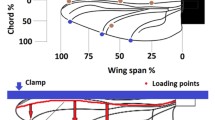Abstract
This work presents our understanding of insect wings, and the design and micromachining of artificial wings with golden ratio-based and tapered veins. The geometric anisotropy of Leading Edge Veins (LEVs) selected by Diptera has a function able to evade impact. As a Diptera example, the elliptic hollow LEVs of cranefly wings are mechanically and aerodynamically significant. In this paper, an artificial wing was designed to be a fractal structure by mimicking cranefly wings and incorporating cross-veins and discal cell. Standard technologies of Microelectromechanical Systems (MEMS) were employed to materialize the design using the selected material. One SU-8 wing sample, light and stiff enough to be comparable to fresh cranefly wings, was presented. The as-prepared SU-8 wings are faithful to real wings not only in weight and vein pattern, but also in flexural stiffness and mass distribution. Thus our method renders possible mimicking with good fidelity of natural wings with complex geometry and morphology.
Similar content being viewed by others
References
Bolsman C T, Pålsson B, Goosen H F L, Schmidt R H M, van Keulen F. The use of resonant structures for miniaturizing FMAVs. 3rd US-European Competition and Workshop on Micro Air Vehicle Systems (MAV07) & European Micro Air Vehicle Conference and Flight Competition (EMAV2007), Toulouse, France, 2007.
Dickinson M H, Lehmann F-O, Sane S P. Wing rotation and the aerodynamic basis of insect flight. Science, 1999, 284, 1954–1960.
Young J, Walker S M, Bomphrey R J, Taylor G K, Thomas A L R. Details of insect wing design and deformation enhance aerodynamic function and flight efficiency. Science, 2009, 325, 1549–1552.
Lehmann F-O. The mechanisms of lift enhancement in insect flight. Naturwissenschaften, 2004, 91, 101–122.
Ennos A R. The importance of torsion in the design of insect wings. Journal of Experimental Biology, 1988, 140, 137–160.
Wootton R J. Functional morphology of insect wings. Annual Review of Entomology, 1992, 37, 113–140.
Combes S A, Daniel T L. Flexural stiffness in insect wings I: Scaling and the influence of wing venation. Journal of Experimental Biology, 2003, 206, 2979–2987.
Vincent J F V, Wegst U G K. Design and mechanical properties of insect cuticle. Arthropod Structure & Development, 2004, 33, 187–199.
Pornsin-sirirak T N, Tai Y C, Nassef H, Ho C M. Titanium- alloy MEMS wing technology for a micro aerial vehicle application. Sensors and Actuators A: Physical, 2001, 89, 95–103.
Shang J K, Combes S A, Finio B M, Wood R J. Artificial insect wings of diverse morphology for flap**-wing micro air vehicles. Bioinspiration & Biomimetics, 2009, 4, 036002.
Tanaka H, Wood R J. Fabrication of corrugated artificial insect wings using laser micromachined molds. Journal of Micromechanics and Microengineering, 2010, 20, 075008.
Tanaka H, Matsumoto K, Shimoyama I. Fabrication of a three-dimensional insect-wing model by micromolding of thermosetting resin with a thin elastmeric mold. Journal of Micromechanics and Microengineering, 2007, 17, 2485–2490.
Ennos A R. A comparative study of the flight mechanism of Diptera. Journal of Experimental Biology, 1987, 127, 355–372.
Brodsky A K. Vortex formation in the tethered flight of the peacock butterfly Inachis io L. (Lepidoptera, Nymphalidae) and some aspects of insect flight evolution. Journal of Experimental Biology, 1991, 161, 77–95.
Sun M, Du G. Lift and power requirements of hovering insect flight. Acta Mechanica Sinica, 2003, 19, 458–469.
Chan W P, Prete F, Dickinson M H. Visual input to the efferent control system of a fly’s “gyroscope”. Science, 1998, 280, 289–292.
Dargent T, Bao X Q, Grondel S, Le Brun G, Paquet J B, Soyer C, Cattan E. Micromachining of an SU-8 flap**- wing flying micro-electro-mechanical system. Journal of Micromechanics and Microengineering, 2009, 19, 085028.
Dargent T, Grondel S, Paquet J B, Cattan E, Soyer C. Vibrating wing analysis with passive torsion for micro flying robot. IEEE/RSJ IROS 2008, 2008, 451–457.
Bao X Q, Dargent T, Cattan E. Micromachining SU-8 pivot structuresusing AZ photoresist as direct sacrificial layers for a large wing displacement. Journal of Micromechanics and Microengineering, 2010, 20, 025005.
Bao X Q, Dargent T, Grondel S, Paquet J B, Cattan E. Improved micromachining of all SU-8 3D structures for a biologically inspired flying robot. Microelectronic Engineering, 2011. (in press)
Schmid S, Hierold C. Dam** mechanisms of single- clamped and prestressed double-clamped resonant polymer microbeams. Journal of Applied Physics, 2008, 104, 093516.
Zimmer M, Diestelhorst O, Lunau K. Courtship in long-legged flies (Diptera: Dolichopodidae): Function and evolution of signals. Behavioral Ecology, 2003, 14, 526–530.
Mandelbrot B B. The Fractal Geometry of Nature, W.H. Freeman and Company, New York, USA, 1982.
West J B, Brown J H, Enquist B J. A general model for the origin of allometric scaling laws in biology. Science, 1997, 276, 122–126.
Sameoto D, Tsang S-H, Foulds I G, Lee S-W, Parameswaran M. Control of the out-of-plane curvature in SU-8 compliant microstructures by exposure dose and baking times. Journal of Micromechanics and Microengineering, 2007, 17, 1093–1098.
Gaudet M, Camart J C, Buchaillot L, Arscott S. Variation of absorption coefficient and determination of critical dose of SU-8 at 365 nm. Applied Physics Letters, 2006, 88, 024107.
Author information
Authors and Affiliations
Corresponding author
Rights and permissions
About this article
Cite this article
Bao, X.Q., Cattan, E. Golden ratio-based and tapered Diptera inspired wings: Their design and fabrication using standard MEMS technology. J Bionic Eng 8, 174–180 (2011). https://doi.org/10.1016/S1672-6529(11)60023-1
Published:
Issue Date:
DOI: https://doi.org/10.1016/S1672-6529(11)60023-1



